
Nur Jahan was the last and chief wife of the Mughal emperor Jahangir and is considered by historians to have been the real power behind the throne for much of her husband's reign.

The Dīn-i-Ilāhī, known during its time as Tawḥīd-i-Ilāhī or Divine Faith, was a syncretic religion or spiritual leadership program propounded by the Mughal emperor Akbar in 1582, intending to merge some of the elements of the religions of his empire, and thereby reconcile the differences that divided his subjects. The elements were primarily drawn from Islam, Hinduism, and Zoroastrianism, but some others were also taken from Christianity, Jainism, and Buddhism.

Abu'l-Fazl ibn Mubarak, also known as Abul Fazl, Abu'l Fadl and Abu'l-Fadl 'Allami, was the grand vizier of the Mughal emperor Akbar, from his appointment in 1579 until his death in 1602. He was the author of the Akbarnama, the official history of Akbar's reign in three volumes, and a Persian translation of the Bible. He was also one of the Nine Jewels of Akbar's royal court and the brother of Faizi, the poet laureate of Emperor Akbar.
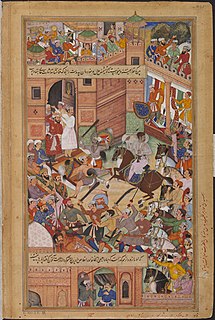
The Akbarnama, which translates to Book of Akbar, the official chronicle of the reign of Akbar, the third Mughal Emperor, commissioned by Akbar himself and written by his court historian and biographer, Abu'l-Fazl ibn Mubarak. It was written in Persian, which was the literary language of the Mughals, and includes vivid and detailed descriptions of his life and times. It followed the Baburnama, the more personal memoir by his grandfather, Babur, founder of the dynasty. Like that, it was produced in the form of lavishly illustrated manuscripts.
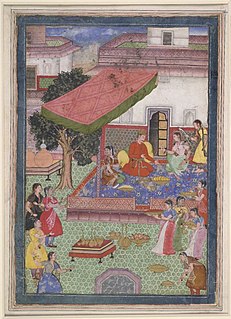
Zenana literally meaning "of the women" or "pertaining to women," in Persian language contextually refers to the part of a house belonging to a Muslim, Sikh, or Hindu family in the Indian subcontinent which is reserved for the women of the household. The zenana are the inner apartments of a house in which the women of the family live. The outer apartments for guests and men are called the mardana. Conceptually in those that practise purdah, it is the equivalent in the Indian subcontinent of the harem.
Mihr-un-nissa Begum, also known as Banu Begum and Bahu Begum, and better known as Ladli Begum, was the daughter of Empress Nur Jahan and her first husband Sher Afgan of the Mughal Empire. She was the wife of Prince Shahryar Mirza, son of Emperor Jahangir.
Darogas were police officials in the Mughal Empire and the British Raj. In the Mughal Empire, a daroga was superintendent of the "slaves" of a Mughal monarch.
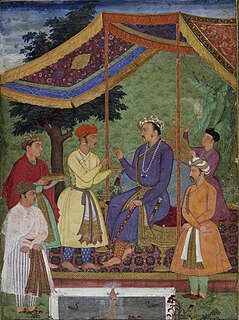
Khusrau Mirza was the eldest son of the Mughal emperor Jahangir. He was the favorite grandson of Mughal Emperor Akbar and his favorite consort Mariam-uz-Zamani who was the grandmother of the prince. The young prince displayed exceptional skills and wisdom and had the privileged to be groomed by the Mughal Emperor Akbar himself for the throne of the Mughal Empire. He turned out to be the most capable and competent son of Jahangir but was befallen to an unfortunate destiny. The charismatic prince was beloved of common people widely known for his valor, secularism, battlefield talent and was free of all vices of the people of his age.

Murad Mirza was a Mughal prince as the second surviving son of Mughal Emperor Akbar. He was the maternal grandfather of Nadira Banu Begum, wife of Prince Dara Shikoh.
Khas Mahal, meaning "The exquisite one of the palace", was the wife of the Mughal emperor Jahangir.
Muqayyash is an ancient craft of brocade embroidery work with silver yarn on silk cloth from Gujarat, India. The silk is ornamented with a silver stripe pattern. Muqayyash is one of the Mughal period silk cloth, and it is recorded in Ain-i-Akbari. The muqayyash was one of the fine brocades of Gujrat among a tus, daraibaf, kurtahwar. It was one of the expensive cloths of that time, priced at 2-50 gold Muhr.
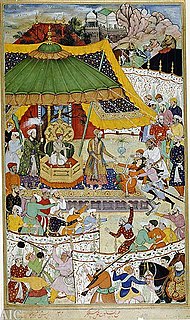
Mughal karkhanas were the manufacturing houses and workshops for craftsmen, established by the Mughals in their empire. Karkhana is a Hindustani language word that means factory. These karkhanas were small manufacturing units for various arts and crafts as well as for the emperor's household and military needs. karkhanas were named and classified based on the nature of the job. For example, 'Rangkhana' and 'Chhapakhana' were for textile dyeing and printing work. The term 'tushak-khana' was used to describe workshops that made shawls and embellished them with embroidery or needlework. Imperial or Royal Karkhanas were for luxury goods and weapons. The karkhanas were the place for various production activities and also for the exploration of new techniques and innovations. Some operations such as weaving, embroidery work, and brocade work were often done under one roof, resembling an integrated assembly line.
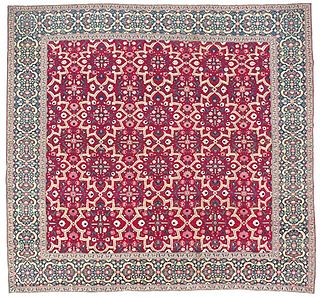
Mughal carpets were the handwoven floor coverings used in the Mughal Empire in their courts. Mughal carpets and rugs have their roots in India since the 16th and 17th centuries. Mughal carpets were a blend of Persian and Indian artistry uniquely designed with scenic landscapes, floral, and animal patterns. Kashmir was producing the finest wool and silk carpets and rugs, including prayer rugs. Sometimes the knot density in these rugs was so fine and tight as 300 knots per square centimeter.

Katzeb was an article of dress encircling the body, at the waist with ends hanging in the front. It was a kind of sash also called Patka.
Chautar or Chaotaer is an old cotton fabric of the Mughal period. The chautar was a mulmul variety, and the finest mulmul was termed as ''Mulmul Shahi'' in Hindi and Persian languages. It was produced in Eastern India. Way back, Chittagong was exporting this cloth. Conceivably then cloths were produced in smaller pieces only since the Chautar is described as a piece good. It has been recorded with specific dimensions, i.e., length 12.44 meters and width 77.75 centimeters. Chautar was compared with sansuo, which was a three shuttle cloth, type of fine cotton variety produced at Songjiang.
Peshwaj was a ladies outfit similar to a gown or jama coat with front open, tied around the waist, having full sleeves, and the length was full neck to heels. Peshwaj was one of the magnificent costumes of the mughal court ladies. The material was used to be sheer and fine muslins with decorated borders of zari and lacework.
Mahmudi, or Maḥmūdī, was a fine cotton variety cloth produced in India.
Katan was a thin silk cloth. It was made of double twisted yarns of pure silk yarns in warp and weft both.
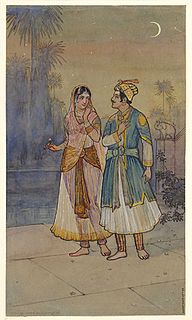
Mulboos khas was a special kind of mulmul cloth made for the King and used for Royal clothing in the Mughal Empire. The Mulboos khas was a kind of first-grade muslin exclusively manufactured in Royal Karkhanas notedly in places like Dacca, Sonargaon, Jangalbaree. Nur Jahan, the empress, was a great admirer of Dacca muslins. Mulboos khas was the finest and most expensive type of muslin, and it was used exclusively in Imperial use.











